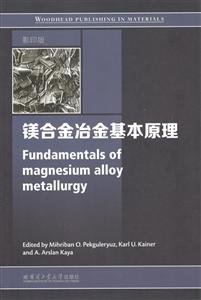-
>
公路車寶典(ZINN的公路車維修與保養秘籍)
-
>
晶體管電路設計(下)
-
>
基于個性化設計策略的智能交通系統關鍵技術
-
>
花樣百出:貴州少數民族圖案填色
-
>
山東教育出版社有限公司技術轉移與技術創新歷史叢書中國高等技術教育的蘇化(1949—1961)以北京地區為中心
-
>
鐵路機車概要.交流傳動內燃.電力機車
-
>
利維坦的道德困境:早期現代政治哲學的問題與脈絡
鎂合金冶金基本原理 版權信息
- ISBN:9787560363912
- 條形碼:9787560363912 ; 978-7-5603-6391-2
- 裝幀:一般膠版紙
- 冊數:暫無
- 重量:暫無
- 所屬分類:>
鎂合金冶金基本原理 內容簡介
《鎂合金冶金基本原理(影印版 英文版)》介紹了鎂合金冶金的基本理論和技術,主要包括:鎂的物理冶金、鎂合金的熱力學性能、鎂合金的沉淀析出過程、鎂的合金化及鎂合金設計、鎂合金成形、鎂合金腐蝕及表面處理等,重點介紹了鎂合金及鎂基復合材料在航空、汽車、醫療器械等領域的應用。 《鎂合金冶金基本原理(影印版 英文版)》對鎂合金熔煉及成形加工技術的研究和生產具有參考價值,適合冶金、材料加工等行業的工程技術人員使用,也可供高等院校相關專業的師生參考。
鎂合金冶金基本原理 目錄
1 Primary production of magnesium
1.1 Introduction
1.2 Raw materials and production methods
1.3 Chemistry of extraction of magnesium from raw material
1.4 Fused salt electrolysis
1.5 Impurity removal chemistry in thermal processing
1.6 Process equipment
1.7 Melting, refining and casting magnesium
1.8 Magnesium alloy powder
1.9 Future trends
1.10 Conclusion
1.11 References
2 Physical metallurgy of magnesium
2.1 Introduction
2.2 Crystal structure and its consequences
2.3 Plastic deformation behaviour of magnesium and its alloys
2.4 Critical resolved shear stress (CRSS), slip and twinning
2.5 Fatigue behaviour
2.6 Creep behaviour
2.7 Recrystallization and grain growth
2.8 Future trends
2.9 References
3 Thermodynamic properties of magnesium alloys
3.1 Introduction
3.2 Fundamentals of thermodynamics
3.3 Thermodynamic properties of Mg alloys and compounds
3.4 First-principles thermodynamics of Mg alloys and compounds
3.5 Future trends
3.6 Acknowledgements
3.7 References
4 Understanding precipitation processes in magnesium alloys
4.1 Introduction
4.2 Precipitation from supersaturated solid solution
4.3 Precipitation hardening magnesium based alloy systems
4.4 Role of precipitation hardening in the development of high strength magnesium alloys
4.5 Conclusions and future trends
4.6 Sources of further information and advice
4.7 References
5 Alloying behavior of magnesium and alloy design
5.1 Introduction
5.2 Alloy design: solid solution alloying of magnesium
5.3 Alloy design: compound formation in magnesium alloys
5.4 The effects of second phases on the mechanical behavior of magnesium
5.5 Alloying with surface-active elements
5.6 Alloying elements and their effects
5.7 Summary: magnesium alloy design to enhance properties
5.8 References
6 Forming of magnesium and its alloys
6.1 Introduction
6.2 Testing for formability
6.3 Deformation mechanisms and formability
6.4 Yield characteristics and drawability
6.5 Work hardening and stretching
6.6 Failure strain behaviour, compression, rolling and bending
6.7 Superplastic deformation and hot forming
6.8 Hot cracking and extrusion
6.9 Conclusions: key issues affecting the formability of magnesium
6.10 Future trends
6.11 References
7 Corrosion and surface finishing of magnesium and its alloys
7.1 Introduction
7.2 Magnesium corrosion in aqueous media
7.3 Surface finishing
7.4 Implications for improving corrosion resistance and future trends
7.5 Conclusions
7.6 References
8 Applications: aerospace, automotive and other structural applications of magnesium
8.1 Introduction
8.2 Material properties
8.3 Alloy development
8.4 Manufacturing process development
8.5 Aerospace applications
8.6 Automotive applications
8.7 Other applications
8.8 Future trends
8.9 Acknowledgements
8.10 References
9 Applications: magnesium-based metal matrix composites (MMCs)
9.1 Introduction
9.2 Reinforcements for magnesium metal matrix composites (MMCs)
9.3 Processing of magnesium composites
9.4 Interfaces, wetting and compatibility
9.5 Properties of magnesium-based MMCs
9.6 Conclusions and future trends
9.7 References
10 Applications: use of magnesium in medical applications
10.1 Introduction to biodegradable implants based on metals
10.2 Fundamental concepts of biodegradation
10.3 Magnesium-based biodegradable metals
10.4 Recent research and future product development
10.5 Sources of further information and advice
10.6 References
10.7 Appendix: list of abbreviations
Index
鎂合金冶金基本原理 節選
《鎂合金冶金基本原理(影印版 英文版)》: An industrially important and relevant property,namely damping,is worthmentioning when discussing the elastic behaviour of magnesium.As a gen—eral rule, we can state that lower strength, annealed conditions,larger grainsizes and lower solute contents would result in better damping properties.It is generally citecl that magnesium has better damping characteristics thanils competitor light weight metals aluminium and titanium.43 Different mag—nesium alloy systems may display good damping properties at a variety of temperatUfes,in many cases outside the range of current interest in magne—sium alloys.For automotive power—train applications, for example, only puremagnesium appears to promise a high damping peak for the relevant tem—perature range, which is of little use as pure metal is not useable in thoseapplications.45 It should be borne in mind that the choice of alloy in terms ofdamping capacity should be assessed based on the frequency and amplitudeof the vibration or noise,and the temperature involved in the particular appli—cation of concern. ……
- >
山海經
- >
史學評論
- >
經典常談
- >
唐代進士錄
- >
李白與唐代文化
- >
新文學天穹兩巨星--魯迅與胡適/紅燭學術叢書(紅燭學術叢書)
- >
巴金-再思錄
- >
隨園食單

















